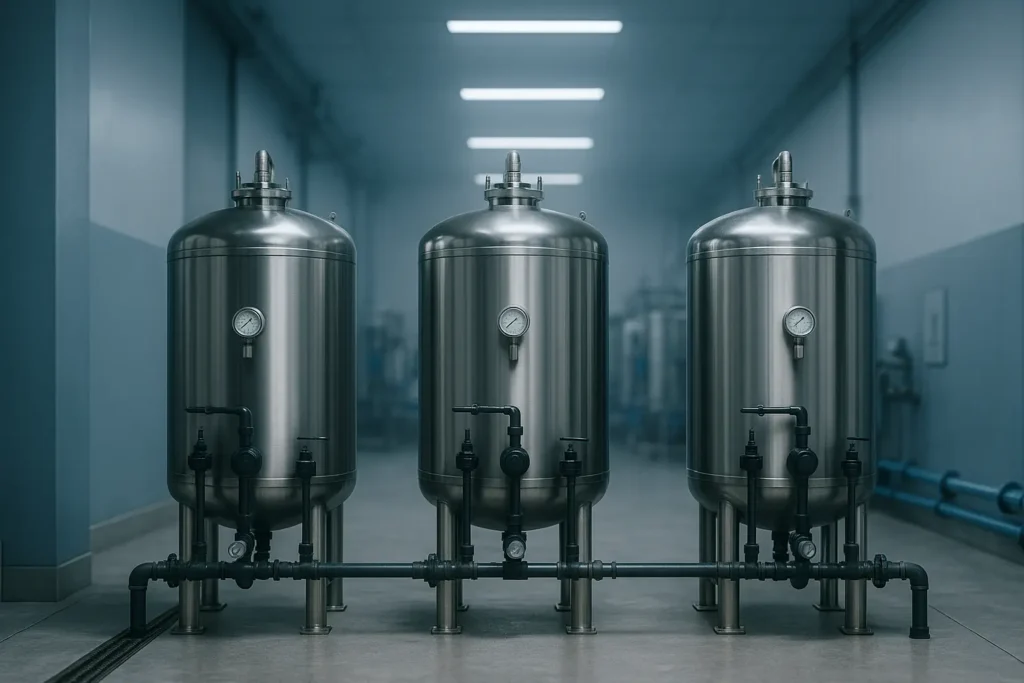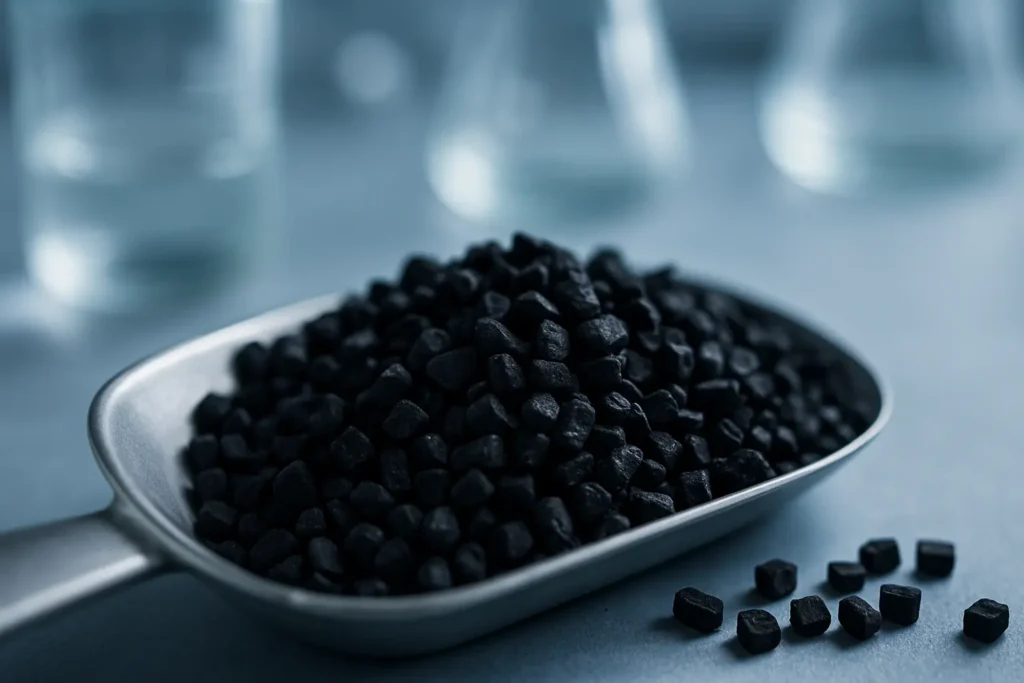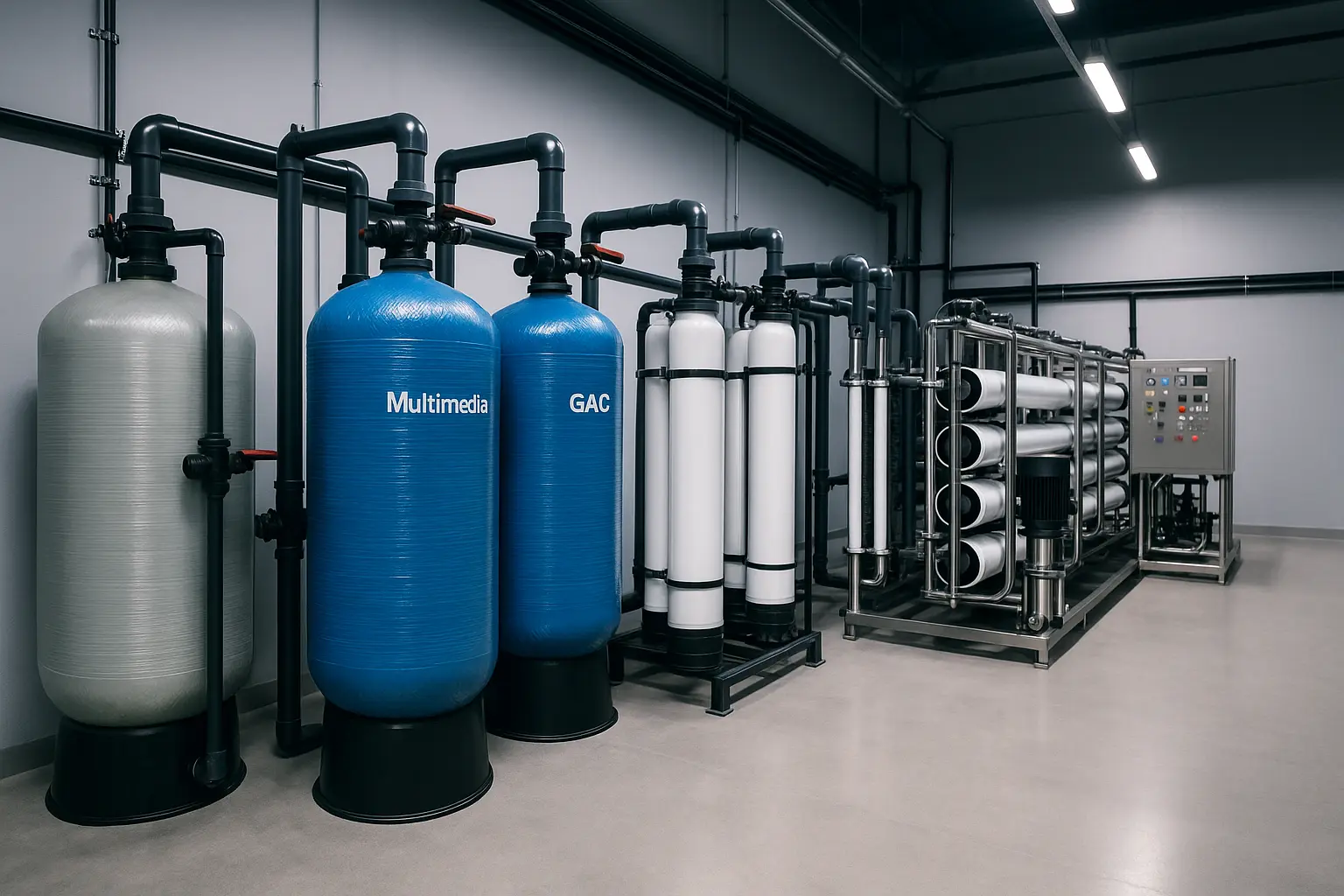Activated carbon (AC) is a porous carbon material with extremely high surface area and a spectrum of micro/meso pores. In industrial water it is the go-to media for removing chlorine/chloramine, odor, taste, color and many dissolved organics (e.g., pesticides, detergents, THMs). It is also used ahead of reverse osmosis to protect membranes and downstream polishing. This guide explains how activated carbon works, its material types and product forms, where it fits, what it cannot do, and how to size, sanitize and maintain it in real plants. Core taxonomy is adapted from your Chinese notes.

1) What is activated carbon and how does it work?
Activated carbon is produced by carbonizing a suitable raw material then “activating” it (steam/chemical activation) to create a highly porous structure. Removal mechanisms include physical adsorption (van der Waals forces, pore filling) and chemical adsorption/catalysis (e.g., dechlorination and chloramine breakdown). Larger surface area and the right pore size distribution drive capacity and kinetics.
- Great for: free chlorine/chloramine, taste & odor, color, many organics, residual oxidants, some heavy-metal complexes.
- Not for: TDS/salts, hardness, nitrate by itself, and most dissolved minerals (pair with RO/IX when needed).
2) Material types (feedstocks) of activated carbon
The feedstock controls hardness, pore distribution and trace ions. Choose by water chemistry and mechanical duty.
| Jenis | Notes & properties | Typical usage |
|---|---|---|
| Coconut shell (coco) / nut shell | Hard, high micro-pore; excellent for chlorine & organics; common in potable and RO pretreatment. | GAC beds and CTO blocks in drinking water & RO protection. |
| Coal-based | Robust, balanced micro/meso pores; good hydraulics for large filters; quality varies by mine. | Municipal/industrial GAC filters, large EBCT service. |
| Wood-based | More meso/macropores; faster kinetics for larger organics and color bodies. | Color/tannin removal, special organics. |
| Bone char | Calcium-phosphate surface chemistry; niche use for certain metals/fluoride. | Specialty polishing when specified. |
| Silver-impregnated carbon | Slow Ag+ release for bio-suppression; must control silver migration vs. local limits. | Point-of-use or microbial-risk conditions (verify compliance). |
3) Activated carbon product forms: GAC, PAC, ACF and CTO
GAC — Granular Activated CarbonIndustrial standard for fixed beds. Mesh size balances kinetics vs. headloss; typical 10–24 mesh for large vessels, 16–32 mesh for compact filters. Backwashable; can be reactivated or rebedded.PAC — Powdered Activated CarbonFine powder dosed as slurry or used in cartridges. Good for shock loads/color spikes; not backwashable as a bed.ACF — Activated Carbon FiberVery high surface area and fast mass transfer in thin modules; higher cost and bio-risk; used when response speed matters.CTO — Carbon Block (sintered)Extruded/sintered with binder; provides adsorption plus nominal filtration (≈3–20 μm). Capacity lower than GAC; compact and convenient for POU/POE.
Cartridge claims should follow recognized product standards such as NSF/ANSI 42/53 guidance.
4) Where activated carbon fits in the process train
- RO pretreatment: dechlorination and organics reduction to protect membranes; usually after multimedia filtration and before fine cartridges/RO.
- Post-treatment/polishing: taste/odor/color control downstream of desalting.
- Special cases: PAC dosing in equalization tanks for transient organics; pairing with upstream oxidation/KDF where specified.

5) Sizing essentials for GAC filters
- EBCT (empty bed contact time): 5–10 min for chlorine/chloramine duties; 10–20 min where dissolved organics dominate (project-specific verification required).
- Hidrolika: design service/backwash rates per OEM; target 30–50% bed expansion in backwash (temperature dependent).
- Mesh & headloss: smaller granules improve kinetics but raise ΔP and fines carryover risk—match underdrain/strainers.
- Instrumentasi: influent/effluent free chlorine (or ORP), ΔP, flow, periodic TOC/color; sample ports and drains for maintenance.
- Changeout/rebed: based on breakthrough (e.g., free chlorine leakage, TOC/color rise) or excessive ΔP; keep a baseline and trend capacity.
For background design context on GAC in drinking-water treatment, see the U.S. EPA drinking water resources.
6) Risks, hygiene & control measures
- Bio-growth: AC can harbor microbes. Control with hot-water/chemical sanitation schedules, UV after GAC where allowed, and correct backwash routines.
- Dechlorination safety: ensure complete removal ahead of RO to avoid membrane oxidation; verify with online analyzers.
- Nitrite risk: in ammonia-bearing feeds, monitor nitrite post-GAC; add UV or specified polishing where required.
- Silver grades: confirm silver release vs. local regulatory limits; perform commissioning flush and keep records.
For potable-water limits and compliance context, refer to the WHO drinking-water quality guidelines.
7) GAC vs PAC vs ACF vs CTO — quick comparison
| Form | Kekuatan | Limits | Best use |
|---|---|---|---|
| GAC | Rebed/backwashable; large throughput; strong for chlorine & many organics | Needs tanks & sanitation; bio-risk if unmanaged | RO pretreatment and polishing filters |
| PAC | Fast response; good for shocks | Handling/settling; not a fixed bed | Color spikes, batch treatment, emergency events |
| ACF | Very fast kinetics; thin modules | Higher cost; bio-risk | Compact modules, rapid response polishing |
| CTO block | Compact; adsorption + nominal filtration | Lower adsorption than GAC; clogs faster than PP | POU/POE cartridges, small systems |
8) Purchasing checklist (BOM) & recommended accessories
- Pressure vessels (FRP/SS) sized for EBCT and backwash; underdrain/strainers matched to mesh size.
- Activated carbon media (grade & mesh per spec); sample ports and sight glass.
- Flowmeters, ΔP gauges, free-chlorine analyzer or ORP; TOC/color monitoring as required.
- Downstream disinfection and cartridge filters & dosing pumps.
- For tanks and hygienic hardware see stainless-steel products.
9) Pertanyaan yang Sering Diajukan
Does activated carbon remove TDS?
Tidak. Activated carbon adsorbs organics and oxidants but not dissolved salts or hardness—pair with RO/IX for desalting.
Which is better for drinking water—coconut or coal?
Both perform well. Coconut often offers higher micropore volume for compact filters; coal grades provide robust hydraulics for large beds. Choose by water chemistry and EBCT target.
How do I know when to change carbon?
Track breakthrough (e.g., free chlorine at outlet, color/TOC rise) and ΔP. Always trend against flow and temperature.
Can activated carbon breed bacteria?
Yes if unmanaged. Use sanitation cycles, UV after GAC where appropriate, and correct backwash. Monitor nitrite when ammonia is present.
10) Next steps
Need help selecting karbon aktif grade, mesh and EBCT for your line? Share feed data and target specs—our engineers can send a sizing note and BOM for review. Request a quick recommendation →
Related reads: RO process & O&M guide - Inside-out UF — what it is & where it fits
Tim Teknik Air Stark — RO/GAC/IX design, retrofits & commissioning

